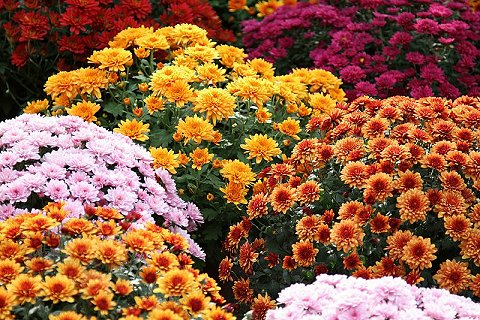|
Plants
for your home
(By Mary Efanti)
Chrysanthemum

Origin
In Greek its name means the flower of gold, although there is another local name
after a Christian Saint whose name-day is celebrated in October when the
chrysanthemums are in full bloom. It is said that it originated in the Far East,
China and Japan. The Dutch were the first to introduce this flower to Europe
where it has been cultivated for years, while in Greece chrysanthemums are part
of almost every garden or balcony.
Description
Its wonderful
flowers, in a
huge variety of colors and sizes, carry a yellow disk at their center like a
daisy, although in many varieties the petals of the flower are so dense that you
cannot see this disk. Exception to that is what we call the Dutch chrysanthemum,
a hybrid (a combination of chrysanthemums and daisies).
The main stem of the chrysanthemums is divided into many smaller ones, each
carrying 3 or more buds. The buds bloom in stages and flowers last for many days.
Chrysanthemums have dense foliage, in dark green color while the underside of
the leaves is gray-green. Their height varies between approximately 20cm and 1 m
depending on the specific variety and the quality of the soil.
Cultivation
Chrysanthemums do very well in
almost any type of soil but they prefer rich soil, containing sand and clay, and
good drainage.
They possess a rich root system and in this way they manage to make good use of
all the moisture in the soil, an attribute that makes them quite resistant to
high temperatures.
Chrysanthemums need direct sunlight to reach bloom and they can handle the hot
sunlight as well as very high temperatures. When in blooming, make sure to
reduce the amount of direct light, on warm and sunny days, because the flowers
may get sunburned. Keeping them out of the hot sun will also help maintain
flowers a little longer. During the summer, place the pots in a well-lit spot
but not under the hot rays of the summer sun.
If cultivated in pots, water them when the top soil is dry to the touch or when
you see their leaves starting to wither. Be careful not to over-water as their
roots rot easily.
Care
During
the blooming season, cut the spent flowers in order to help maintain the new
flowers and to keep your plant well groomed.
When all the flowers are spent, cut them off and prune the plant. Discard of the
lower leaves which must have gone dry by this time, and cut the stems that
carried flowers a little higher from the point that the main stem is divided
into smaller ones. The plant will look quite ugly but soon new growth will
appear as well as many new offshoots next to the main stem.
Keep watering throughout the year, less often in winter and more often during
the summer. If your chrysanthemums are in a pot, on very hot summer days you may
need to water everyday
Check
the plant very carefully and very often, especially on the tender tops or on the
underside of leaves and flowers for black or green tiny flies, called aphids,
which is a usual pest to chrysanthemums. If you notice any aphids, move the
diseased plant away from any other plants in order to avoid the disease
spreading. Visit your local nursery, get the suitable chemical (in powder form)
and use according to the instructions. Always follow closely the instructions on
the packaging.
You could try a more “practical” non-toxic solution. Dissolve 3-4 drops of
ordinary dishwashing liquid and some “blue” alcohol in lukewarm water and
spray the plant, making sure that the underside of the leaves is covered with
the solution. Repeat the same process 10-15 days later and you should get rid of
aphids. Another way, express but quite risky, is to spray the aphids with an
ordinary household insecticide and place the plant in shade. Of course, expect
to see the tender new leaves dry out and fall (because of the insecticide) but
you will get rid of the aphids in no time. Be careful, use this method only on
plants situated outside your home, as its intense odor makes repellents
dangerous for use in spaces with poor ventilation, like our homes in winter.
In the Vase
Chrysanthemums
are beautiful either in the garden or in the vase. They make excellent cut
flowers and here is a little tip on how to preserve them in the vase much longer:
each time you change the water in the vase, add half an aspirin. Do not forget
to replace the water every day, shorten the stems, and discard of leaves that
are under the surface of water, the same way you would care for any cut flowers.
Mary Efanti
mefanti@otenet.gr
|
